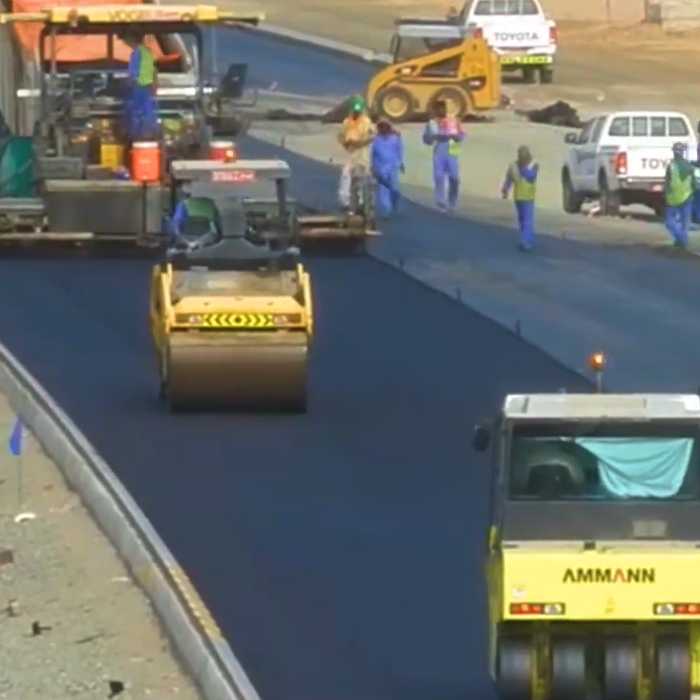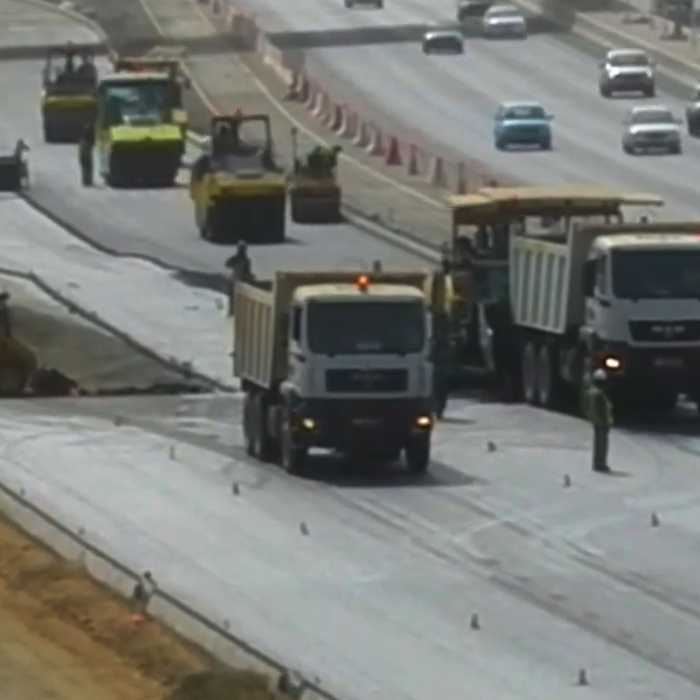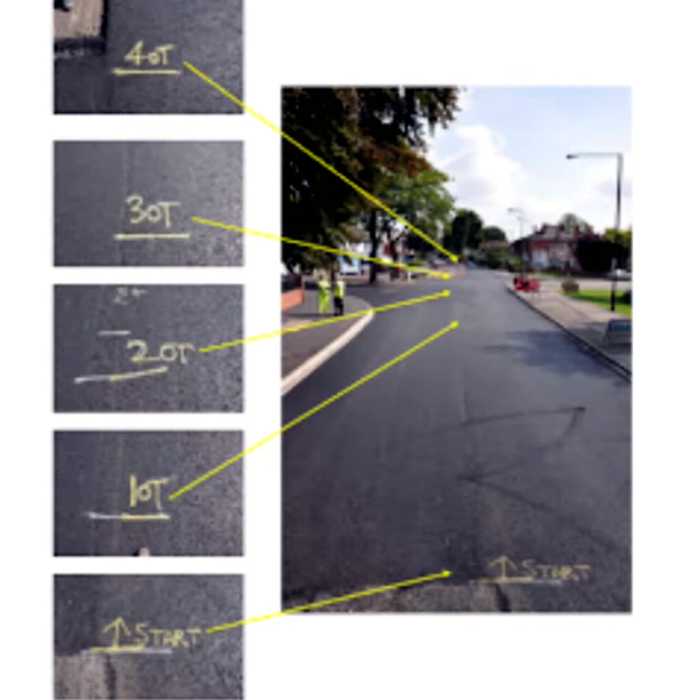My name is Steve Axton and I’ve been working with asphalt crews for over 15 years now. In that time, I’ve learned a lot about how these crews operate daily and the processes involved in laying and drying asphalt. As someone with first-hand experience, I can tell you that drying time is crucial when it comes to asphalt paving. The crews aim to start early to beat the midday heat, which can soften the asphalt mix and extend the drying time. Proper planning and efficiency right from the start of the shift are key to ensuring the asphalt dries within the expected timeframe.
In this article, I’ll share an insider’s perspective on how an asphalt crew prepares for the day, lays down the hot mix, and allows for proper drying time. I’ll also discuss what’s needed from workers in terms of skills, credentials, and the right mentality for this demanding job. My goal is to give readers a better understanding of why drying time varies and how crews work to pave efficiently. I am sure that you will accelerate your asphalt mastery and achieve faster, high-quality results with our expert advice.
Getting an Early Start to Beat the Heat
Asphalt crews know that environmental conditions play a major role in drying times. In the height of summer, drying can take 6-12 hours. That time frame can double if paving happens during the hottest part of the day. For this reason, work typically starts in the early morning hours.
It’s common for crew members to be on-site by 6 or 7 AM to start preparing for the day. Those early shift start times allow paving to happen when temperatures are cooler and the asphalt will dry faster. No one wants to be raking hot mix when the thermometer hits 90 degrees!
Starting early is crucial, but safety is always the priority. The first order of business is a series of warm-up stretches and safety briefings. Proper physical conditioning and constant vigilance for hazards are vital in this line of work.

Why Upfront Planning Matters
Successful asphalt drying starts well before crews arrive on site. Experienced teams know the paving process intimately and plan proactively based on project details. They consider key factors that influence drying time such as:
- Job specifications (thickness, mix type, traffic needs)
- Production capacity needed
- Environmental conditions
- Crew skills/equipment
Thorough planning ensures they can pave and dry asphalt efficiently despite fluid conditions. Let’s examine how prep work sets the stage for responsive execution.
Prep Work Sets Up an Efficient Process
Once the safety talks are done, the crews mobilize quickly to maximize productivity. Laborer team members fetch tools and materials needed for the day. They also direct dump trucks and position traffic control signage around work areas.
Proper prep work ensures the paving process flows smoothly once trucks start rolling in. With zones marked off, traffic redirected, and tools in place, the crew can focus on their primary tasks. Prepping for efficiency makes a big difference when paving mile after mile of roadway.
The more coordinated the crews are in the prep phase, the faster the asphalt can be laid down and compacted. Lack of organization early on can lead to costly delays that allow the hot mix to cool off too much. The last thing the crew wants is to pave and compact below the ideal temperature range.

Analyze Project Requirements
The first step is studying project plans to understand specifications that impact drying:
- Asphalt thickness – Thinner 1-2 inch mats dry faster than 3-4 inch overlays.
- Mix type – Custom asphalt formulations have different drying behaviors.
- Production rate – Total tons to be paved daily determines workflow.
- Traffic control – Limiting routes slows drying but allows safer public access.
Crews must have a firm grasp on expectations before designing a production plan. Specific project parameters inform how to approach the job.
Paving and Compacting is a Race Against Time
Once prep work is complete, the paving process begins in earnest. Dump trucks deliver loads of fresh hot mix asphalt to be laid down. Crew members work urgently to spread and compact the mix within an optimal temperature window.

Laborers have one of the toughest jobs on the crew. They constantly rake, shovel, and move the hot asphalt into place. At the same time, operators run compaction rollers over the fresh mat to compress it to the desired density.
This process continues non-stop to complete long sections of roadway. On a big job, crews can put down several thousand tons of asphalt each day. The entire process is a race against time before the mix cools and stiffens up.
Working efficiently with coordination and teamwork is the only way to achieve quality results in such a tight timeframe. No one can afford to slow down or get distracted during this labor-intensive phase. The crews know they have just 8-12 hours before the asphalt becomes unworkable.
What it Takes to Handle an Asphalt Job
Evaluate Environmental Factors
Next, analyze historical weather data at the job location during the scheduled timeframe. Temperature, precipitation patterns, wind, and sunlight exposure all affect drying. For example, paving in June in Arizona requires a different strategy than November paving in Maine. Seasonal variations even within the same region must be accounted for.
While forecasts offer a general guide, actual conditions will vary day to day. Flexibility is still essential, but historical trends provide a baseline for initial plans.

Tailor the Plan to Crew Abilities
Finally, assess the team’s skills and equipment to handle the specific project demands.
- Are traffic control specialists needed to keep the public safe?
- Can the same crew handle paving and compaction?
- Is specialized equipment required based on the mix being used?
Optimal crew assignment and machinery improve efficiency. Planning proactively avoids bottlenecks or slowdowns related to capabilities. With a solid project analysis completed, the crew can develop schedules and assignments to facilitate speedy drying in their specific context. Let’s examine execution strategies to complement planning.
Execution Strategies That Accelerate Drying
Even great project plans must adapt to real-time conditions. Strategic execution is vital to rapid asphalt drying through:
- Adjusting work for weather changes
- Staggering operations for continuous paving
- Quality control monitoring across the project
- Proactive traffic control improvements
Skilled crews don’t just follow a rigid plan. They dynamically optimize the schedule based on ground truths.
Adjust to Ever-Changing Weather
No weather forecast is perfect. A predicted partly cloudy day might become overcast. Expected rain may hold off and allow more paving.
Crews must monitor trends closely and adjust operations to take advantage of good weather or mitigate bad conditions:
- More sun than expected? Accelerate production.
- Overcast and cool? Slow down paving to prevent thermal shock.
- Rain approaching? Compact just-paved areas to seal out moisture.
Proactive weather analysis and responsiveness keep projects on an optimal timeline even when conditions are unpredictable.
Stagger Operations for Continuous Paving
Non-stop paving is far more efficient than a start-stop approach. By staggering trucking, paving, rolling, and crew shifts, operations become continuous.
For example:
- Shift 1 preps site and lays asphalt from 7 AM to 4 PM.
- Shift 2 compacts and sets up for the next day from 12 PM to 9 PM.
Overlapping the work prevents equipment and materials from sitting idle. The asphalt stays hot and drying progresses faster with fewer stops.
Monitor Quality Across the Project
Consistent drying relies on uniform compaction and adhesion across the paved surface. Quality control testing at multiple points identifies any weak spots.
Crews take core samples and measure:
- Asphalt thickness
- Density
- Smoothness
Catching deficiencies early prevents major problems down the road. It also indicates where more rolling is needed to accelerate drying through improved compaction.
It is important to know that laying down asphalt quickly and correctly takes total dedication from crew members. The job requires physical strength, endurance, and the ability to work outdoors in all weather conditions. Make no mistake about it, this is one of the most demanding jobs in construction.
Beyond sheer toughness, several other traits are equally important:
- Reliability – Crews depend on everyone to show up ready to work every day. Lack of consistency from even one or two members slows down the operation.
- Teamwork – Success depends on how well the crew communicates and works together. There’s no room for individuals to think about themselves.
- Learning mindset – An asphalt crew deals with new challenges on every job. Being adaptable and eager to gain new skills is essential.
Beyond the right work ethic, certain credentials demonstrate a person’s ability to perform safely and skillfully:
- Commercial driver license – Required for dump truck drivers and equipment operators. Backing up quickly with heavy loads takes specialized skills.
- OSHA 10 certification – Everyone on the crew needs training in standard safety principles and hazard awareness.
- Equipment operation certificates – Specialized knowledge is needed to run pavers, rollers, and other machinery properly.
Proper licenses and certifications show that laborers will work in a safe, productive manner. With the right attitude and documented skills, they can handle the demands of the job.
Climbing the Ranks as a Laborer
An asphalt crew offers opportunities for eager workers to take on more responsibility over time. Reliable performance in a laborer role is the first step on the path.
Showing initiative and desire to learn opens the door for advancement. I know first-hand that crew leaders take notice of which laborers express interest in gaining more experience. When chances come up to help operators or shadow crew chiefs in off-hours, grab them!
Those who put in extra time learning protocols and assisting on different equipment demonstrate dedication. They gain valuable knowledge by seeing operations from different angles. Over time, a laborer can get certified on equipment and start operating it regularly to help the crew.
Moving up takes patience and persistence, but the rewards are worth it. With each new skill, laborers gain the expertise to deliver safe, quality-focused results day after day. Their efforts are vital to completing asphalt projects on schedule.
Refine Traffic Control as Needed
The traffic control plan enables safe public movement without vehicles damaging unfinished asphalt. As paving progresses, crews analyze if modifications would speed drying:
- Can certain sections be opened early to reduce traffic backups?
- Are detours or closures possible on side streets to allow more room?
Savvy crews don’t just set and forget the traffic plan. They tweak it to balance community mobility and rapid drying. By actively looking for small improvements throughout operations, crews maximize productivity and asphalt drying.
Table 1: Variables that Impact Asphalt Drying Time
| Factor | Effect on Drying Time |
|---|---|
| Temperature | Higher temps speed drying. Cooler weather extends drying. |
| Cloud cover | More sun exposure dries asphalt faster. Overcast skies slow drying. |
| Humidity | Drier conditions accelerate drying. High humidity prolongs drying. |
| Wind | Breezy conditions improve drying. Calm winds allow moisture to linger. |
| Mat thickness | Thin 1-2” layers dry quicker than 3-4” overlays. |
| Asphalt type | Custom mixes have different drying behaviors. |
| Compaction quality | Better adhesion and density speed drying. Poor compaction exposes moisture. |
| Traffic volume | More controlled traffic allows faster drying. Heavy traffic delays full curing. |
| Paving size | Bigger areas mean longer drying time. Small patches cure quicker. |
With so many variables, flexibility is mandatory for efficient results. What dries in 6 hours one day may take 10 hours the next. Strict cutoffs are unrealistic.
Instead, crews track the asphalt’s progress hourly and gauge when traffic can safely resume. Experience informs the judgment calls in ever-changing conditions.
Achieve Faster Drying Through Adaptability
Asphalt crews have more control over drying time than they realize. Instead of leaving it totally to chance, strategic planning and execution makes all the difference:
- Analyze project specs, weather data, and crew capabilities to design an optimal plan.
- Adjust operations as conditions change to maximize productivity.
- Communicate across shifts to enable continuous around-the-clock paving.
- Refine quality and traffic control to accelerate safe drying.
With the right preparations and nimble teamwork, crews can master the art of fast asphalt drying, even when factors seem beyond their control. The key is embracing flexibility rather than relying on fixed formulas.
In my recent meeting with CNN, I asked these questions from the interviewers here are the questions with answers.
What time do I recommend asphalt crews start each day?
As an experienced civil engineer, I’ve seen crews arrive as early as 5-6 AM during summer months. The goal is to pave while it’s coolest and allow maximum drying time before peak heat arrives. Starting early optimizes the entire process.
How should work zones be safely set up on a road paving project?
Proper work zone setup is crucial for both safety and efficiency. I advise crews to position advanced warning signs and traffic cones to redirect vehicles well before the active work area. Flaggers provide guidance at key points to minimize disruption yet maintain public access. The paving train itself serves as a rolling work zone once operating.
What tools and materials must be ready before paving starts?
I recommend crews stage all necessary tools like rakes, lutes, and shovels near the paving site beforehand. Materials like tack coat, extra asphalt mix, and sealing agents should also be on hand. Proactive staging helps paving proceed smoothly once trucks start delivering hot loads.
In my experience, why is paving asphalt risky during the hottest parts of the day?
Midday heat softens the asphalt mix, preventing proper compaction and drying. The mat takes longer to cure and is more prone to damage from equipment or early traffic. Based on what I’ve seen, paving when temps exceed 90°F risks substandard results.
How soon can traffic drive on new asphalt pavement?
It depends on factors like thickness and weather, but I advise crews to closely monitor conditions and open lanes as soon as safely possible. Testing for hardness, marking tire imprints, and checking texture help determine when traffic can resume without damage.
What hand tools do asphalt laborers use daily on the job?
Based on my observations, laborers rely on tools like rakes, lutes, shovels, and tampers to spread, prep, and compact asphalt manually. Keeping these tools in adequate condition and supply is essential to avoiding delays. Optional items like knee pads and cooling towels can boost comfort on hot days.
How does weather impact the asphalt drying timeline in my experience?
Temperature, wind, humidity, and sunlight all affect drying times. Cool, cloudy conditions can double drying times compared to hot, sunny weather. Crews must adapt plans and procedures based on real-time conditions.
What credentials show an asphalt worker is properly qualified?
Relevant certifications include commercial driving licenses, OSHA-10 training, flagger qualifications, equipment operator certification, and DOT hazard materials transport. Proper licensing proves crews have the specialized skills for safe, quality results.
Why is teamwork ability so important for asphalt crews?
Paving requires close coordination between trucking, paving, and rolling. A weak link in communication or effort slows the entire process. Based on what I’ve seen, crews functioning as a unified team achieve the greatest productivity and efficiency.
How does asphalt mix design affect the drying process?
Specific aggregates and liquid asphalt formulations have different thermal properties that impact drying rate. In my experience, crews familiar with a mix’s tendencies can better predict curing times under various weather scenarios.
What inspection tests indicate adequate compaction?
I recommend checking core samples for proper density and thickness. Additional visual and tactile tests can evaluate smoothness, moisture, and hardness. Deficient areas can then be quickly reworked while the asphalt is still malleable.
Why is prep work so crucial before the paving train arrives?
Advance preparation minimizes downtime between truckloads based on what I’ve observed. Flagging, tools, materials, and equipment must be ready to sustain workflow. Insufficient prep leads to delays as fresh mixes cool and harden.
How does asphalt thickness influence drying time?
Thicker mats contain more material volume to cure through. A 4-inch overlay may take twice as long to dry fully compared to a 2-inch layer. I advise crews to allow drying times to scale proportionally with thickness.
What techniques can accelerate asphalt drying times?
Direct sunlight, optimal compaction, preventing moisture exposure, controlled traffic, and thin lifts speed drying in my experience. But the biggest factor is scheduling paving during peak heating hours and finishing before temperature drop.
How do crews determine when traffic can drive on new asphalt?
Beyond checking hardness and texture by hand, I recommend marking freshly paved areas with a weighted tire. If minimal imprinting occurs after 30-60 minutes, the mat has likely hardened enough to allow vehicles without damage.
Why is pre-project planning so important for efficient paving?
Proactive planning allows optimization of logistics for the specific job parameters. Evaluating traffic, mix needs, weather, and equipment prevents delays compared to a generic approach.
What causes asphalt tearing or damage during paving operations?
Insufficient tack coat adhesion, under-compressed surfaces, and tight vehicle turning can scuff or tear fresh asphalt. Damage also occurs when traffic is allowed before adequate drying and hardening happens.
How can crews prevent asphalt mixes from cooling too quickly?
Continuous production flow keeps material hot based on my observations. Coordination between dump trucks, paver, and rollers ensures no gaps. Staffing shifts to permit overnight paving also retains heat.
What tactical adjustments help crews adapt to unexpected weather delays?
If rain or excessive heat shuts down production, I advise shifting focus to prep work like patching, crack sealing, tack application, or shoulder grading to maximize time.
Why should rollers stay close behind the paver?
Compacting while the mat is still piping hot prevents cooling and densification issues. Letting asphalt sit unused can lead to a weaker end product. Staying close delivers optimal results in my experience.
What are the most physically demanding asphalt crew roles?
Laborers face the most physical work from constant shoveling, raking, tamping, and moving around the site. Roller operators also endure vibration and heat working close to fresh asphalt.
What does the quality control manager assess throughout paving?
This individual checks temperature, smoothness, thickness, and compaction at set intervals based on what I’ve observed. They identify any deficiencies immediately so the crew can rework them before continuing paving.
Why must asphalt workers be adaptable and open to learning?
Each paving project presents unique conditions and challenges. Crews must be flexible and eager to expand their skills as circumstances dictate. Stubborn rigidity often leads to poor outcomes.
How soon can lane striping be added after asphalt is paved?
I only recommend adding striping and marking after the material has fully dried and hardened, often taking 7+ days. Premature painting risks bonding and imprinting issues. I hope these detailed answers from my 25+ years of experience provide helpful insights into asphalt paving and drying! Let me know if you have any other questions.
At the end of the day, the crews take pride in achieving quality results despite the challenges of their work. With the right team of dedicated and skilled members, hot asphalt gets laid down smoothly and allowed to dry properly. That high standard of workmanship keeps our transportation infrastructure running smoothly year after year. As both an engineer and construction specialist, I’ve learned first-hand how proactive planning and adaptable execution enable success on projects of all sizes and complexities. I hope these insider tips on mastering asphalt drying strategies prove helpful for crews seeking continuous improvement. Let me know in the comments if this post has provided valuable insights from the trenches!
